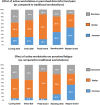Feasibility and acceptability of "active" classroom workstations among French university students and lecturers: a pilot study
- PMID: 34044813
- PMCID: PMC8161641
- DOI: 10.1186/s12889-021-11074-3
Feasibility and acceptability of "active" classroom workstations among French university students and lecturers: a pilot study
Abstract
Background: Sedentary lifestyles plague today's society in terms of physical, psychosocial and cognitive health. Students are particularly at risk because they spend most of their daily time sitting and inactive. The current pedagogical model must be rethought in order to promote students' health, well-being and therefore their success. The objective of this project was to equip one classroom of the sport science department at a university with various active workstations (standing desks, Swiss balls, cycling desks, pedal- or stepper-board) and to evaluate the feasibility and influence of these types of active workstations on the cognitive and psychological factors of the students, and to collect the feedback of lecturers during this experience.
Methods: Participation in the study was voluntary and students had the opportunity to choose or not to use an active workstation during lectures. A total of 663 students and 14 lecturers completed a survey to evaluate subjective feelings about physical, psycho-cognitive and academic aspects after their first experience with active workstations in the classroom.
Results: The majority of students and lecturers reported positive effects of active workstations in reducing fatigue, distraction, and boredom. The preferred active workstations were the cycling desks and the Swiss balls. Finally, 89.4% of students favoured using active workstations in future lectures if they had the option, as well as 71% of lecturers, demonstrating the acceptance of such active workstations.
Conclusion: The present study brings promising results toward a more general implementation of active workstations in universities. Once a familiarisation period is observed, having such workstations in the classroom could help prevent the deleterious effect of sedentary behaviour and promote a more active daily life for the future.
Keywords: Classroom; College; Cycling desk; Sedentary lifestyle; Standing desk.
Conflict of interest statement
The authors declare that they have no competing interests.
Figures



Similar articles
-
The impact and perceptions of standing desk interventions on movement patterns and physical, mental, and academic outcomes in university students: a scoping review.BMC Public Health. 2025 May 9;25(1):1726. doi: 10.1186/s12889-025-22912-z. BMC Public Health. 2025. PMID: 40346487 Free PMC article.
-
Implementation of Active Workstations in University Libraries-A Comparison of Portable Pedal Exercise Machines and Standing Desks.Int J Environ Res Public Health. 2018 Jun 12;15(6):1242. doi: 10.3390/ijerph15061242. Int J Environ Res Public Health. 2018. PMID: 29895760 Free PMC article.
-
Learning to Stand: The Acceptability and Feasibility of Introducing Standing Desks into College Classrooms.Int J Environ Res Public Health. 2016 Aug 15;13(8):823. doi: 10.3390/ijerph13080823. Int J Environ Res Public Health. 2016. PMID: 27537901 Free PMC article.
-
Standing Breaks in Lectures Improve University Students' Self-Perceived Physical, Mental, and Cognitive Condition.Int J Environ Res Public Health. 2021 Apr 15;18(8):4204. doi: 10.3390/ijerph18084204. Int J Environ Res Public Health. 2021. PMID: 33921094 Free PMC article.
-
Health and productivity at work: which active workstation for which benefits: a systematic review.Occup Environ Med. 2019 May;76(5):281-294. doi: 10.1136/oemed-2018-105397. Epub 2019 Jan 28. Occup Environ Med. 2019. PMID: 30692162
Cited by
-
Cardiometabolic and neuromuscular analyses of the sit-to-stand transition to question its role in reducing sedentary patterns.Eur J Appl Physiol. 2022 Jul;122(7):1727-1739. doi: 10.1007/s00421-022-04954-y. Epub 2022 Apr 27. Eur J Appl Physiol. 2022. PMID: 35474143
-
The impact and perceptions of standing desk interventions on movement patterns and physical, mental, and academic outcomes in university students: a scoping review.BMC Public Health. 2025 May 9;25(1):1726. doi: 10.1186/s12889-025-22912-z. BMC Public Health. 2025. PMID: 40346487 Free PMC article.
-
The impact of acute bike desk usage before encoding and during early consolidation on memory task performance in university students and use case evaluation in an educational setting.PLoS One. 2025 Mar 17;20(3):e0319658. doi: 10.1371/journal.pone.0319658. eCollection 2025. PLoS One. 2025. PMID: 40095995 Free PMC article.
-
Classroom Movement Breaks and Physically Active Learning Are Feasible, Reduce Sedentary Behaviour and Fatigue, and May Increase Focus in University Students: A Systematic Review and Meta-Analysis.Int J Environ Res Public Health. 2022 Jun 24;19(13):7775. doi: 10.3390/ijerph19137775. Int J Environ Res Public Health. 2022. PMID: 35805432 Free PMC article.
References
-
- WHO. Préambule à la Constitution de l’Organisation mondiale de la Santé, tel qu’adopté par la Conférence internationale sur la Santé, New York, 19 juin −22 juillet 1946; signé le 22 juillet 1946 par les représentants de 61 Etats. (Actes officiels de l’Organisa. in (1946).
-
- Young DR, Hivert MF, Alhassan S, Camhi SM, Ferguson JF, Katzmarzyk PT, Lewis CE, Owen N, Perry CK, Siddique J, Yong CM, Physical Activity Committee of the Council on Lifestyle and Cardiometabolic Health; Council on Clinical Cardiology; Council on Epidemiology and Prevention; Council on Functional Genomics and Translational Biology; and Stroke Council Sedentary behavior and cardiovascular morbidity and mortality: a science advisory from the American Heart Association. Circulation. 2016;134(13):e262–e279. doi: 10.1161/CIR.0000000000000440. - DOI - PubMed
Publication types
MeSH terms
LinkOut - more resources
Full Text Sources
Other Literature Sources

